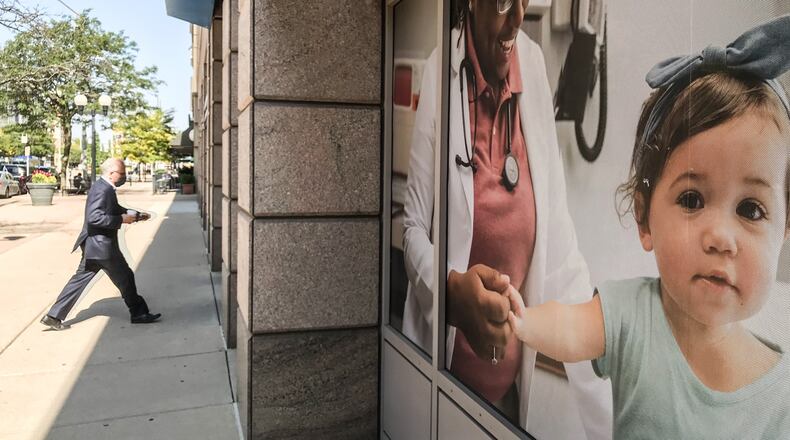News of the workforce cuts comes at a time when hospital systems and health care companies are laboring under something of a paradox. Because of the lingering pandemic, some patients may be wary of seeing doctors for routine health care, all while that very pandemic is making health care arguably more important than ever.
A competing hospital network and a downtown Dayton managed care insurance provider similarly have had to refine their business models.
The Premier Health workforce reduction could impact around 130-260 jobs. Position cuts include clinical and support roles, management and staff positions, according to a Premier Health spokesperson.
An American Hospital Association report published this summer found that hospitals are struggling to come to grips with “historic reductions in hospital inpatient and outpatient volumes, which have in turn driven drastic reductions in revenues and margins — all of which can impact hospitals' and health systems' abilities to serve their communities.”
The AHA report said patient volume is expected to remain well below “baseline levels,” and it estimated that a “minimum” of $120.5 billion in financial losses, for the rest of year, are possible.
“We, like other providers regionally and nationally, have experienced changing industry headwinds in recent years, some of which have intensified significantly during the current pandemic,” Premier said. "Our financial performance is under pressure from these industry headwinds, which include what we are paid for our care by government and private payers; continued shifts of care to the outpatient setting; changing consumer preferences; and the rapid adoption of telehealth.
“The entire industry – not just Premier Health – understands that we must transform,” the statement continued. “To position our organization to best serve the community through our organization’s next three-year strategic plan (2021-23), we are eliminating certain vacancies, transitioning certain roles, and undertaking a reduction in force — steps taken by other health care providers in our region and across the nation.”
Premier is one of the largest private employers in the Dayton region and operates Miami Valley Hospital, Atrium Medical Center and Upper Valley Medical Center as well as a network of physicians and outpatient centers.
A spokeswoman for Kettering Health Network, which operates Kettering Medical Center, Soin Medical Center in Beavercreek and Sycamore Medical Center in Miamisburg, among other hospitals, said her company has responded to the pandemic by “flexing down" employment before once again returning workers to their jobs.
“We utilized several staffing strategies, including furlough options, that focused on supporting onsite teams in the delivery of safe patient care, providing resources for employees in areas most significantly impacted by low volumes, and maintaining the flexibility to return teams to work quickly as patient volumes returned,” KHN said. “In recent weeks, we have seen patient volumes rebound more quickly than anticipated for our industry, and we have been able to flex back up.”
Kettering Health did not say how many employees were furloughed and did not respond to question about whether the company has had to lay workers off.
CareSource, one of downtown’s most prominent employers, said it has eliminated about 80 positions in the past six months.
“As part of our focus on driving quality health outcomes for our members, CareSource recently introduced a redesigned care model to align with industry best practices,” the company said. “With the transition to the centralized model, some areas took on duplicate roles and were overstaffed which resulted in the elimination of some positions, many of which will be absorbed elsewhere.”
The downtown-based health insurance company covers 1.8 million people between Ohio, Kentucky, Indiana, West Virginia and Georgia. The company employs more than 2,200 people in Dayton and 4,000 in Ohio.
Zachary Jenkins, an associate professor of pharmacy practice at Cedarville University, said it’s a challenging time for hospitals. When government lock-down orders in March closed the doors to routine outpatient medical care for some patients, that cut down on hospital referrals and created what today is a long waiting list in some areas of patients who need care.
And there remain some regional pockets nationwide where COVID-19 is stressing some hospital systems, Jenkins said.
“We do need to encourage people that this (visiting doctors and hospitals) is a controlled risk,” Jenkins said.
About the Author

